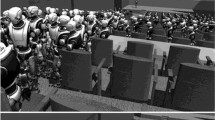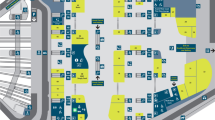Abstract
Critical infrastructure protection represents one of the main challenges for decision makers today. This paper focuses on rail-based public transport and on the interaction of the station layout with passenger flows. Recurring patterns and accumulation points with high passenger densities are of great importance for an analysis since they represent e.g. critical areas for surveillance and tracking and further security implementations. An agent-based model is developed for crowd behavior in railway stations. For the analysis, we apply the methodology of data farming, an iterative, data-driven analysis process similar to the design of simulation experiments. It uses experimental designs to scan the parameter space of the model and analyses the data of the simulation runs with methods stemming from statistics and data mining. With its help, critical parameter constellations can be identified and investigated in detail.
Similar content being viewed by others
References
Billari, F.C., Fent, T., Prskawetz, A., Scheffran, J. (eds.) Agent-Based Computational Modelling. Physica-Verlag, Heidelberg (2006)
Brandstein, A.G., Horne, G.E.: Data farming: a meta-technique for research in the 21st century. Maneuver warfare science 1988, US Marine Corps Combat Development Command Publication (1998)
Dehmer, M., Meyer-Nieberg, S., Mihelcic, G., Pickl, S., Zsifkovits, M.: Collaborative risk management for national security and strategic foresight. EURO J. Decision Process. 3, 1–33 (2015)
Dehmer, M., Nistor, M., Schmitz, W., Neubecker, K.: Aspects of quantitative analysis of transportation networks. Future Security (2015)
Gu, L., Yang, J.-F.: Construction of nearly orthogonal latin hypercube designs. Metrika 76(6), 819–830 (2013)
Hastie, T., Tibshirani, R., Friedman, J.: The Elements of Statistical Learning. Springer Series in Statistics, 2nd edn. Springer, New York (2009)
Hernandez, A.S., Lucas, T.W., Carlyle, M.: Constructing nearly orthogonal latin hypercubes for any nonsaturated run-variable combination. ACM Trans. Model. Comput. Simul. 22(4), 1–17 (2012)
Liebig, T., Xu, Z., May, M.: Incorporating mobility patterns in pedestrian quantity estimation and sensor placement. In: Nin, J., Villatoro, D. (eds.) Citizen in Sensor Networks. Lecture Notes in Computer Science, vol. 7685, pp. 67–80. Springer, Berlin (2013)
Macal, C.M., North, M.J.: Tutorial on agent-based modelling and simulation. J. Simul. 4(3), 151–162 (2010)
Meyer-Nieberg, S., Zsifkovits, M., Pickl, S., Brauner, F.: Assessing passenger flows and security measure implementations in public transportation systems. Future Security (2015)
Neutert, J.-P.: Empirische Studie über das Personenverhalten am Münchener Hauptbahnhof. Praktikumsbericht. Universität der Bundeswehr München (2015)
North, M., Macal, C.: Foundations of and recent advances in artificial life modeling with repast 3 and repast simphony. Artificial Life Models in Software, pp. 37–60. Springer, New York (2009)
Pickl, S., Lechleuthner, A., Mudimu, O., Dehmer, M.: Exploring data analysis techniques for threat estimation. Future Security (2015)
Räty, T.: Survey on contemporary remote surveillance systems for public safety. IEEE Trans. Syst. Man Cybern. Part C: Appl. Rev. 40(5), 493–515 (2010)
Sforza, A., Starita, S., Sterle, C.: Optimal location of security devices. In: Setola, R., Sforza, A., Vittorini, V., Pragliola, C. (eds.) Railway Infrastructure Security, Topics in Safety, Risk, Reliability and Quality, vol. 27, pp. 171–196. Springer International Publishing, Cham (2015)
Valera, M., Velastin, S.A.: Intelligent distributed surveillance systems: a review. IEE Proc. Vis. Image Signal Process. 152, 192–204. IET (2005)
Acknowledgements
The support from the German Federal Ministry of Education and Research (BMBF) (project RiKoV, Grant No.13N12304) is gratefully acknowledgement.
Author information
Authors and Affiliations
Corresponding author
Editor information
Editors and Affiliations
Rights and permissions
Copyright information
© 2017 Springer International Publishing Switzerland
About this paper
Cite this paper
Meyer-Nieberg, S., Zsifkovits, M., Hauschild, D., Luther, S. (2017). Simulation-Based Analyses for Critical Infrastructure Protection: Identifying Risks by Using Data Farming. In: Dörner, K., Ljubic, I., Pflug, G., Tragler, G. (eds) Operations Research Proceedings 2015. Operations Research Proceedings. Springer, Cham. https://doi.org/10.1007/978-3-319-42902-1_47
Download citation
DOI: https://doi.org/10.1007/978-3-319-42902-1_47
Published:
Publisher Name: Springer, Cham
Print ISBN: 978-3-319-42901-4
Online ISBN: 978-3-319-42902-1
eBook Packages: Business and ManagementBusiness and Management (R0)




